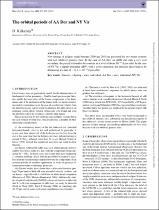| dc.contributor.author | Kilkenny, Dave | |
| dc.date.accessioned | 2023-03-01T13:03:31Z | |
| dc.date.available | 2023-03-01T13:03:31Z | |
| dc.date.issued | 2011 | |
| dc.identifier.citation | Kilkenny, D. (2011). The orbital periods of aa dor and ny vir. Monthly Notices of the Royal Astronomical Society, 412 (1) , 487-491. 10.1111/j.1365-2966.2010.17919.x | en_US |
| dc.identifier.issn | 1365-2966 | |
| dc.identifier.uri | 10.1111/j.1365-2966.2010.17919.x | |
| dc.identifier.uri | http://hdl.handle.net/10566/8486 | |
| dc.description.abstract | New timings of eclipses made between 2000 and 2010 are presented for two binary systems
with hot subdwarf primary stars. In the case of AA Dor, an sdOB star with a very cool
secondary, the period is found to be constant at a level of about 10−14 d per orbit. In the case
of NY Vir, a rapidly pulsating sdBVr with a cool companion, the period is discovered to be
decreasing at a rate of −11.2 × 10−13 d per orbit. Close binary stars are particularly useful for the determination of
fundamental stellar parameters. Double-lined spectroscopic binaries enable the mass ratio of the binary components to be determined and, if the inclination of the binary orbit can be measured or
reasonably constrained (as in the case of an eclipsing system), then
the absolute masses can be found. In addition, the light curve of an
eclipsing system allows relative stellar radii to be found and even
the absolute radii if the system is a double-lined binary. | en_US |
| dc.language.iso | en | en_US |
| dc.publisher | Oxford University Press | en_US |
| dc.subject | Physics | en_US |
| dc.subject | Astronomy | en_US |
| dc.subject | Eclipses | en_US |
| dc.subject | Binary subdwarf | en_US |
| dc.title | The orbital periods of aa dor and ny vir | en_US |
| dc.type | Article | en_US |

